by TRA
The History of the Pentacon Six
The Exakta 66 Mk II
Dates: 1989-1997
The Mk II version of the Exakta 66 was probably first available in late spring 1989. Some sources claim that it was available from 1986, but this was not the case. The incorrect reference to 1986 arises from the mistaken belief that no metering prism was available for the Mk I model. The metering prism was available from 1986, for the original version of the camera. I have this information in a letter from Exakta Foto GmbH dated June 1986, and it is confirmed in a full price list for the Exakta 66 supplied to me in a letter from Foto Oehling in Mainz, dated 11th January 1988, which lists the metering prism and makes no reference to a Mk II version of the camera. When I bought my Exakta 66 (i.e., “Mk I”, a term never used by the manufacturer) in Germany on 31st March 1989, no “Mk II” or “Mod 2” was available, and I bought the camera with the TTL metering prism.
It would appear that the Mk II version became available soon thereafter in 1989. An Exakta 66 Mk II was received for repair from the UK distributors of the time, George Elliott, on 26th May 1989. Initially, the Mk II camera was sold alongside the Mk I, although fairly soon it would appear that only Mk II cameras were being bought. The Mk II was known as “Model 2” in German.
Features
The Exakta 66 Mk II responded to criticism in reviews of the original camera, introducing a number of improvements.
Focussing screen
Reviewers had complained that the focussing screen was
too small and that the viewfinder image was too dark. Both of these
problems had been caused by the decision to incorporate in the Exakta 66
focussing screens that were changeable by the user. This was a feature
of some other cameras and was intended to be a strong selling point.
However, in practice, the best of the three available screens was supplied
with the camera and probably few of the other two screens were sold.
Worse, the interchangeable screen was mounted in a black plastic frame
(to facilitate its insertion and removal by users). This had two
undesirable consequences:
|
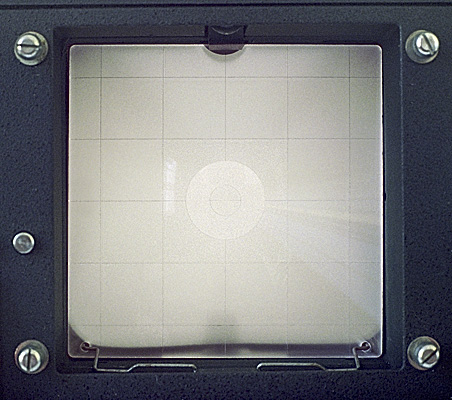
[C387_30A_n2.jpg] The Rollei focussing screen in an Exakta 66 Mk II. I have reproduced this darker than normal and have sharpened the image considerably, to increase the visibility of the composition gridlines and the rangefinder wedges. This has had the side effectof increasing the granularity of the image, which is therefore not as smooth as the screen itself. Note the wire spring used to hold the screen in place. |
| The Exakta 66 (Mk I) lever wind was a great improvement
on the Pentacon Six lever wind, but some reviewers felt it was too difficult
to grab with the thumb. A small extension was added to it, and the
edge of the extension had a series of ridges which improved grip remarkably.
This was a bigger improvement than one might imagine, merely by looking
at it.
When wound fully forward, the new, longer grip fouled the right-hand (viewed from behind) rectangular prism release button. To solve this, the two rectangular buttons on the prism were replaced with lower-profile curved buttons on prisms supplied for the Exakta 66 Mk II. |

The wind lever on the Exakta 66 Mk I [C149_14.jpg] 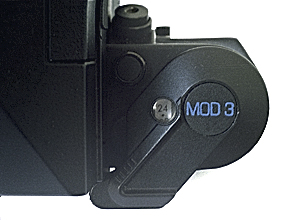
When this Exakta 66 Mk II was upgraded by the factory to Mk III specification, the model name on the Mk II lever wind was changed. [C396_37.jpg] |
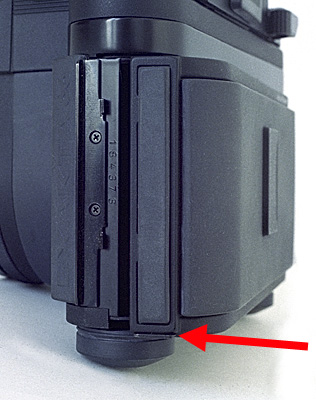
[C387_28Alock.jpg] Spring-loaded back catch arrowed Top-right of the image, one can also see the ribbed end of the film advance lever. |
Someone must have accidentally caught the camera back opening catch on something, resulting in the back opening and the film being fogged. This was not normally a problem with the Pentacon Six, which is generally used in the base of its “ever-ready” case, but there was no such case for the Exakta 66. The manufacturers responded by re-designing the back-opening catch so that it was spring-loaded. Squeeze the door shut without pulling the lever down (if you must; I don’t!), and it will spring up to its locked position. |
Carrying Strap
The cradle and carrying strap for the Exakta 66 were a stroke of genius. But the shoulder pad on the Mk I strap was appalling. Its underside consisted of a shiny transparent plastic sheet that creased up during the manufacturing process. It looked bad, was uncomfortable, and slipped off the shoulder. With Mk II a much-improved all-black rubber shoulder pad solved all these problems.
Flash sync speed
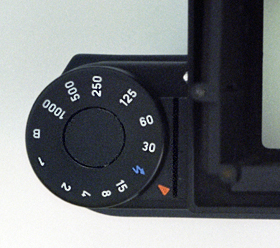
The shutter speed dial on the Exakta 66 Mk I [C149_16sd.jpg] 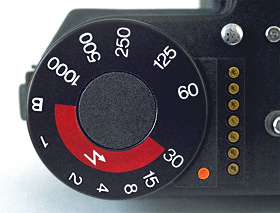
The shutter speed dial on the Exakta 66 Mk II [C387_29A_n.jpg] |
One of the strongest criticisms of the Exakta 66 had
been for its slow flash sync speed of 1/25 sec. For those accustomed
to using a Hasselblad 500 C/M, whose in-lens leaf shutters where synchronised
for flash at all speeds, this was definitely slow. However, some
press criticism was unjustifed and malicious, as for instance when the
Exakta 66 was criticised for this in the British photographic press but
the Pentax 6×7, which had a flash sync speed of 1/30, was praised.
The manufacturers of the Exakta 66 responded by claiming to have increased the flash sync speed from 1/25 to 1/30, although in fact this “improvement” merely consisted of re-labelling the shutter speed dial and marking 30 at the point that had previously been labelled with the electronic flash symbol, so it was in fact still 1/25! This probably did not convince many people, especially as the détente for the real 1/30 was still there, between what was now marked as 1/30 and the 1/60 position. |
Recognizing a Mk II Exakta 66
The easiest way to check at a glance whether a camera is Mk I or Mk II is to look at the top of the camera. Mk II cameras are labelled “MOD 2” on the advance lever and have a bright red segment on the shutter speed dial to show the speeds that synchronise with flash.
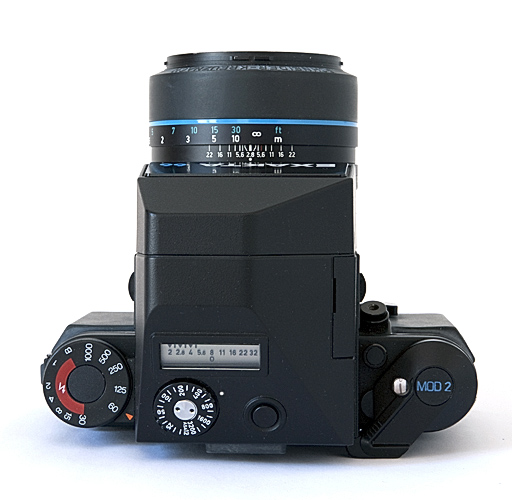
Note also the curved release buttons on each side of the metering prism.
[E66_Mk2.jpg]
To go to the Bibliography, click here.
To go on to the next section, click below.
28 The Exakta 66 Mk III
To go to the beginning of the history section, click here.
To go to introduction to the cameras, click here.
To choose other options, click below.
Home
© TRA August 2010, Revised October 2010, August 2012